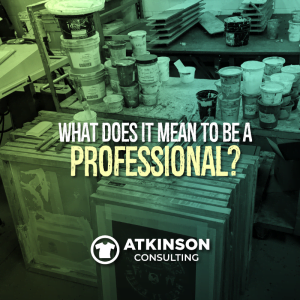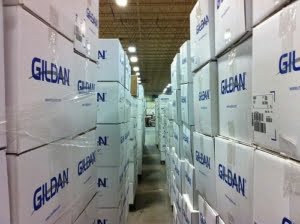Most t-shirt printing shops that I know are only concerned about one thing – getting that particular day’s orders printed and shipped. Thoughts about building a sustainability program seem very earth-crunchy and usually too foreign to contemplate. Maybe it’s too big of a project to start, or maybe the shop is too small and limited on resources. However, it’s really pretty easy if you go into it with the right mindset.
The basic trick that everyone needs to learn is that you can’t do it all at once. A fully functioning sustainability program can really help your business and actually add some much needed margin back into the bottom line if built correctly. I get asked constantly about building sustainability programs, and here are my top “go-to” recommendations to get started:
Start with a Sustainability Committee. You can’t do this alone, and you certainly don’t want to be the energy police and go around the shop yelling “Turn That Off”! The only way to have success is to build it from the ground up. Gather as many interested people in your company together as you can and form a committee. This group should include production staff, office staff, managers and most importantly, your company ownership. There’s an old adage that states “Man supports what he helps create”, and this certainly applies to a sustainability program. Your committee should meet more frequently at the beginning, but once established maybe once a quarter is all that’s needed. Initially, here are a few of the things that should be discussed:
- Goal Setting. Brainstorm with your group and find a few things to work on initially. These could be projects such as starting a recycling program, lowering your energy consumption, or just some basic research into what resources are available to you locally. Set some SMART goals (Specific, Measureable, Achievable, Realistic, & Time Based) and assign due dates.
- Divide Up Responsibilities. Everyone in your group will have a different interest or skill set. Play into that and have them work on things that interest them. If two heads are better than one, how valuable would eight be? What if everyone was to tackle one or two things? Think about how much progress you can make!!
- Set a Meeting Schedule & Method of Reporting. Look at a calendar and decide your meeting schedule for the next year. Also decide on how the committee will communicate to each other and the company as a whole about the program. Buy a bulletin board and start adding important things to it about the program as you progress. This could be minutes from your meeting, results of the program, or maybe just articles about sustainability that are a topic of interest.
- Make It Fun. What are you going to do as a group to make the project fun so everyone can get involved? If you achieve your goal will you have a pizza party or other celebration?
Measure. Start a spreadsheet or two. Remember you can’t manage what you don’t measure. If you have some data from previous years, get that down on your spreadsheet as a baseline. Build different spreadsheets around energy consumption, trash pick-up and recycling, or shop consumables (ink, emulsion, chemicals, etc.) If you can, normalize your totals with the amount of work performed for each time period (week, month, year, etc.) by using the amount of impressions printed. This is important as if you are busier one month or year than another, you naturally will be consuming more energy or materials. What you are looking for though, is to show how efficient that work really is.
Get an Energy Audit. Whether you own your shop space or are just renting, getting an energy audit is probably the number one task to start when building your program. Your local utility company has an auditor that they can send out to your facility to review your shop. They will poke around the building and then come back to you with a report on your yearly energy consumption and usually will have a grocery list of things you can do to help conserve energy in the future. These guys dance cards are usually full, so be prepared to get in line…but it is worth the wait.
Get City, County and State Help. These days you can’t swing a dead cat without hitting a governmental sustainability program. They are in existence to help you and add support to your program. Often, they have money to spend on retrofitting lighting, windows, HVAC or other items for your building. These could be outright grants of money or zero/low interest loans. Thinking of adding some equipment to your shop? One of these entities may help you with the purchase if you can prove that it will save energy. You won’t know unless you ask, so get busy!!
Be Receptive to New Ideas. Most of the time shops are bombarded with sales people wanting to pitch their newest thing. I know my phone and e-mail is jammed every day with folks hawking their wares. The funny thing is that sometimes these guys have something that you haven’t thought of before and may need…and these can be part of your sustainability program. Instead of thinking “we don’t need that, we’ve been doing it the old way for years”, get out of your own way and listen to how new technology could help you. I’m not going to pitch products here, but let me tell you that I’ve found at least six things in the past year that we’ve switched, added or changed that have made a huge impact on our sustainability program and have increased our margins. You won’t know unless you listen.
The Three “R”s. Think about starting your program based on this easy to remember guideline – Reduce, Reuse, Recycle.
- Reduce. Reduce the amount of consumables you are purchasing and using. Using some Lean thinking, examine your workflow and processes and try to see what you can change to reduce the amount of material you are using, energy you are consuming, and steps it takes you to do your work. It’s basically an efficiency mindset. If something takes five steps to do, how can you achieve the same task in three? What can you do to reduce your energy consumption on a daily basis? Small things add up quickly here.
- Reuse. What can you reuse around your shop so you won’t have to purchase new? The easiest example is always shop towels. Why buy new when you can use defective or misprinted shirts? Can you reuse cardboard boxes or drums for something?
- Recycle. More than just soda cans… You can recycle light bulbs, cardboard, paper, batteries, chemicals, computers, office furniture, metal, old equipment, ink, plastic, and other materials. The trick is to find how to do it in your area. To build our recycling program, it took nearly a year’s worth of effort to find a recycling partner that would help us achieve our goals correctly. But in the end, the wait was worth it as they make the program very easy. You just have to keep plugging away!
Talk to People and Share Ideas. In your local community, industry forum, LinkedIn group or any other network you may have there are folks that are either thinking about starting a sustainability program or are already doing something. Share ideas and tips. What worked and what didn’t? How did you get started? Was the local chamber of commerce helpful? Who did you call? Remember you aren’t in this alone, and networking and building your program with the help of others is a good thing. You don’t have to reinvent the wheel and it is 100% ok to copy someone else. There isn’t a test and you don’t get any extra points for being an original.
Equipment Preventative Maintenance. This is not only critical to the life blood of your shop, but makes perfect sense for sustainability too. Make sure every piece of equipment is fully functional and operating at peak efficiency. You should have an equipment log and perform regular maintenance checks to be sure everything is working at peak efficiency. Replace broken or missing parts. It seems obvious, but you would be surprised at how many of your staff just “live with” the challenges with their equipment every day instead of speaking up and getting things fixed. Your managers should be on top of this and constantly asking what is needed or how they can support your teams. Use your eyes and ears when walking the floor and take notes about what could be corrected. Something not look right? Leaking oil? Hearing the hiss of an air leak? Don’t put up with those problems – get them fixed!!
Sign Up for Certification. If you are going to build a program, you may as well do it right and follow best industry practices right? What are the top shops doing? One way to find out is to sign up for and work towards getting your shop certified as a sustainable printer with a third party auditing system. The benefit is that you will learn the skills and guidelines for doing things the right way, and know at the end of the program you can market your company as a certified green printer. My recommendation is to go with the certification from the Sustainable Green Printing Partnership; or SGP for short. (www.sgppartnership.org) The SGP program is extremely robust and will mentor you all along the way towards their certification. When you are ready, an auditor will come out to your shop for two days and examine your program. If you have achieved your goals, you can be certified as a Green Printer and use this label to market yourself. It is a way to differentiate your company in the marketplace, all the while building a best in class program.
Market and Publicize Your Efforts. Don’t keep your program a secret! Shout it out at the top of your lungs and let everyone know what you are doing! Use social media, your newsletters, even discussion with clients and vendors. The more you discuss and promote your program, the more valuable and impactful it will become. Success will keep feeding it, and you’ll start to see some intangible benefits. Remember, always be truthful. Don’t exaggerate and use real science and data when discussing your results. Don’t worry if someone else has better numbers, it’s important to view your program as its own entity and that it is always getting better. The more you celebrate sustainability at your shop, the better results you are going to get.
These are just some initial ideas. The trick is to just get started and score some easy wins. If you would like some help building your program, you can contact me at maktinson4804@gmail.com and I’ll be happy to consult with you on how to get started.




5 comments
customsing
thank u for the tips.. i want to build a printing t shirt company.. and this tips very useful for me..
T Shirt Printing
atkinsontshirt
Great!! Please let me know if you need any mentoring or consulting – I can help…
customsing
sure i will contact you.. thank u Mr. Atkinson.. great to know you..
T Shirt Printing
lakhvir singh
Thanks for share this tips
atkinsontshirt
Lakhvir:
No problem!! Thanks for reading!! Please let me know if I can help you with anything. -M